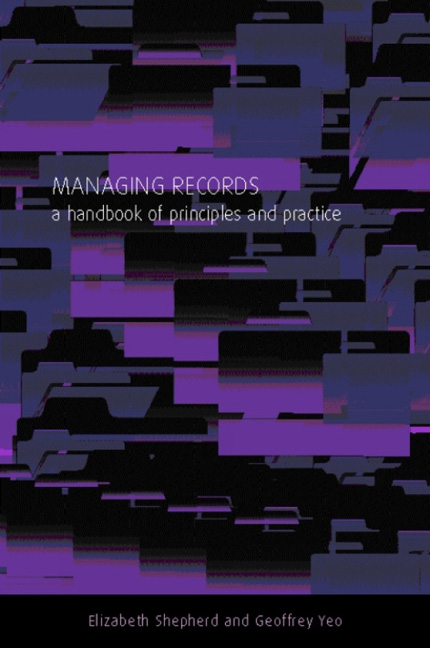Book contents
- Frontmatter
- Contents
- Preface
- Editorial note
- Introduction
- 1 Understanding records management
- 2 Analysing the context for records management
- 3 Classifying records and documenting their context
- 4 Creating and capturing records
- 5 Managing appraisal, retention and disposition
- 6 Maintaining records and assuring their integrity
- 7 Providing access
- 8 Implementing records management: practical and managerial issues
- Conclusion
- Appendix A Bibliography and sources of further information
- Appendix B Select list of national and international standards
- Appendix C Professional organizations for records managers in English-speaking countries
- Index
4 - Creating and capturing records
Published online by Cambridge University Press: 09 June 2018
- Frontmatter
- Contents
- Preface
- Editorial note
- Introduction
- 1 Understanding records management
- 2 Analysing the context for records management
- 3 Classifying records and documenting their context
- 4 Creating and capturing records
- 5 Managing appraisal, retention and disposition
- 6 Maintaining records and assuring their integrity
- 7 Providing access
- 8 Implementing records management: practical and managerial issues
- Conclusion
- Appendix A Bibliography and sources of further information
- Appendix B Select list of national and international standards
- Appendix C Professional organizations for records managers in English-speaking countries
- Index
Summary
Much organizational activity leads naturally to the creation of records, but few organizations seek to record everything that they do. Written communications generate records, but most spoken communications leave no record unless a written note is made, and manual and physical tasks can also pass unrecorded. However, new ways of working and new technologies often make it simpler to create records where none were created in the past. With the growth of e-mail, many messages that might once have been verbal are now written; digital telephony and voicemail have made it easier to capture evidence of telephone communications when records are required. The first part of this chapter examines organizational needs for the creation of records, and discusses the intellectual and practical aspects of managing records at the point of their creation or receipt.
The characteristics that records need (authenticity, integrity, usability and reliability) have been discussed in Chapter 1. Records that have these qualities provide a full and accurate representation of the processes and activities that give rise to them. They serve the purposes of business users, lawyers, auditors and regulators. They underwrite the organization's requirements for accountability and transparency as well as providing for its business needs and corporate memory. A records creation strategy helps to ensure that records meet the appropriate standards of quality, but it is also essential that they are captured into a secure and effective records management system so that these qualities will remain intact over time. The second part of this chapter considers principles and procedures for identifying what needs to be captured and for managing the systematic capture of records in paper and digital form.
Principles of records creation and capture
Identifying where records are needed
Some writers assert that a record should be created and captured for every organizational activity, or at least for every transaction involving more than one party (Bearman, 1994, 300). Others suggest that some processes or some steps within a process may not need to generate records, and that the role of records management is to identify how far each process should be recorded (Reed, 1997, 221–2). In practice this depends on the needs of the organization. Highly regulated industries and organizations whose work is publicly sensitive may need to ensure that every telephone call and every verbal transaction is documented, but in most organizations this is neither necessary nor practical.
- Type
- Chapter
- Information
- Managing Recordsa handbook of principles and practice, pp. 101 - 145Publisher: FacetPrint publication year: 2003



